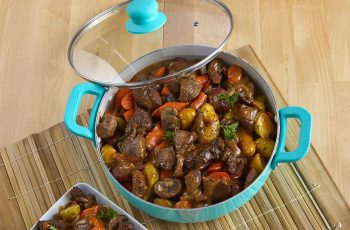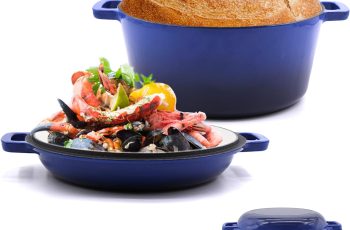Ad Blocker Detected
Our website is made possible by displaying online advertisements to our visitors. Please consider supporting us by disabling your ad blocker.
In the ever-evolving world of culinary arts, there exists an unsung hero, an essential tool that has quietly revolutionized the way we cook: the saucepan. Often overlooked amidst the more glamorous appliances and gadgets of the kitchen, the humble saucepan has, in fact, played a pivotal role in shaping modern cookery. From its versatile design to its ability to evenly distribute heat, this seemingly simple utensil has elevated cooking to new heights. In this article, we will explore the significant impact the saucepan has had on the culinary landscape and the ways in which it has transformed the art of cooking.
The Origins of the Saucepan
Earliest Known Cooking Vessels
Cooking vessels have been used by human beings for thousands of years, with the earliest known examples dating back to prehistoric times. These early cooking vessels were simple in design, often consisting of hollowed-out stones or animal hides used for boiling water or cooking food over an open fire. While these early vessels served their purpose, they lacked the specific features and functionality of a saucepan.
Introduction of Bronze and Iron Pots
As civilizations began to advance, so did the cooking vessels they utilized. The introduction of bronze and iron pots marked a significant technological development in culinary history. These materials allowed for the creation of more durable and heat-conductive cooking vessels, making it easier to control cooking temperatures and enhance the flavors of the food being prepared. However, these pots were still not quite the saucepans we are familiar with today.
Evolution of the Saucepan Design
The saucepan, as we know it, began to emerge during the medieval period. With advancements in metallurgy and the availability of more refined materials such as copper, the design and functionality of cooking vessels improved significantly. The saucepan design evolved to include a rounded shape with a flat bottom and a long handle for easy maneuverability. This allowed for better heat distribution and improved cooking techniques, ultimately shaping the way we cook today.
Advantages of Using a Saucepan
Even Heat Distribution
One of the primary advantages of using a saucepan is its ability to distribute heat evenly across the cooking surface. The rounded shape and flat bottom of a saucepan allow for a consistent temperature throughout, ensuring that food is cooked evenly and preventing any hot or cold spots. This even heat distribution is particularly important when preparing delicate dishes that require precise temperature control, such as sauces or custards.
Versatility for Various Cooking Techniques
While the name may suggest that saucepans are exclusively used for making sauces, they are actually incredibly versatile cooking vessels. The design and construction of a saucepan make it suitable for a wide range of cooking techniques, including simmering, stewing, boiling, and sautéing. The ability to perform multiple cooking methods in a single pot makes the saucepan a staple in both home kitchens and professional culinary environments.
Ease of Use and Cleaning
Saucepans are designed with ease of use and cleaning in mind. The long handle provides a comfortable grip, allowing for easy maneuverability while stirring or pouring. Additionally, many saucepans feature non-stick coatings, making them easier to clean and ensuring that food does not stick to the surface during cooking. The efficient design of the saucepan, along with its user-friendly features, makes it a go-to cookware item for both amateur cooks and professional chefs.
Impact on Culinary Techniques
Simmering and Stewing
The saucepan has had a significant impact on the techniques of simmering and stewing. The shape and size of the saucepan make it ideal for slowly cooking food over low heat, allowing flavors to develop and ingredients to tenderize. Simmering and stewing in a saucepan not only preserve the natural flavors of the ingredients but also result in tender and succulent dishes that are loved by many.
Boiling and Blanching
Boiling is a fundamental cooking technique that is often used in food preparation. Saucepans excel in boiling water quickly and efficiently due to their wide surface area. Whether you need to cook pasta, blanch vegetables, or prepare stocks, the saucepan’s ability to rapidly heat water to boiling point is essential. The precise temperature control and even heat distribution of a saucepan ensure that ingredients are cooked precisely to achieve the desired texture and flavor.
Sautéing and Stir-Frying
Saucepans have also influenced sautéing and stir-frying techniques, although they are more commonly associated with skillets or woks. However, saucepans with a wide base and high sides can be effectively used for these cooking methods, especially when preparing smaller portions or delicate ingredients. The even heat distribution and depth of a saucepan allow for quick and efficient cooking, ensuring that flavors are enhanced and ingredients are cooked to perfection.
Influence on Ingredient Preparation
Preparation of Stocks and Broths
The saucepan plays a crucial role in the preparation of stocks and broths, which are the foundation of many dishes in culinary traditions around the world. The deep shape of a saucepan allows for the efficient extraction of flavors from bones, vegetables, and aromatics, resulting in rich and flavorful stocks. The even heat distribution ensures that ingredients are simmered gently and consistently, allowing for the extraction of maximum flavor.
Tenderizing Tough Cuts of Meat
Tough cuts of meat often require slow and gentle cooking methods to achieve tenderness. The saucepan’s ability to retain heat and distribute it evenly makes it an excellent tool for tenderizing tough cuts of meat. By slowly simmering the meat in liquid, the collagen breaks down, resulting in a more tender and flavorful dish. The saucepan’s design and functionality make it a reliable choice for achieving succulent and melt-in-your-mouth meat preparations.
Creating Flavorful Sauces and Gravies
Saucepans are synonymous with sauces and gravies, and for good reason. The even heat distribution and precise temperature control of a saucepan allow for the reduction and thickening of ingredients to create flavorful sauces. Whether it’s a classic béchamel sauce or a rich pan gravy, the saucepan’s design ensures that ingredients cook evenly and flavors meld together harmoniously. The saucepan has revolutionized the way sauces are prepared and has become an essential tool for professional chefs and home cooks alike.
Revolutionizing Traditional Recipes
Development of One-Pot Dishes
The saucepan has played a pivotal role in revolutionizing traditional recipes by enabling the development of one-pot dishes. By combining ingredients in a single saucepan, flavors meld together, and intricate layers of taste are created. The ability to cook an entire meal in one pot not only saves time and effort but also results in rich and complex dishes. Traditional recipes have evolved to adapt to the convenience and versatility of the saucepan, leading to the creation of countless one-pot wonders enjoyed by food enthusiasts worldwide.
Enhanced Flavors and Textures
The saucepan has significantly enhanced the flavors and textures of traditional recipes. The even heat distribution and precise temperature control of a saucepan ensure that ingredients are cooked uniformly, resulting in dishes that are perfectly seasoned and cooked to perfection. The saucepan’s ability to gently simmer and stew ingredients allows flavors to develop and meld together, creating depth and complexity in every bite. Additionally, the saucepan’s design promotes the retention of moisture, resulting in dishes that are moist and tender.
Time and Energy Efficiency
Saucepan cooking offers significant time and energy efficiencies compared to other cooking methods. With the ability to cook multiple ingredients simultaneously in a single pot, the saucepan eliminates the need for additional cookware and reduces both preparation and cleanup time. Additionally, the even heat distribution of the saucepan ensures that food cooks efficiently and evenly, reducing the amount of energy required for the cooking process. These time and energy efficiencies have made the saucepan a staple in busy kitchens and have shaped the way we approach cooking in our modern, fast-paced lives.
Continue to Part 2…

